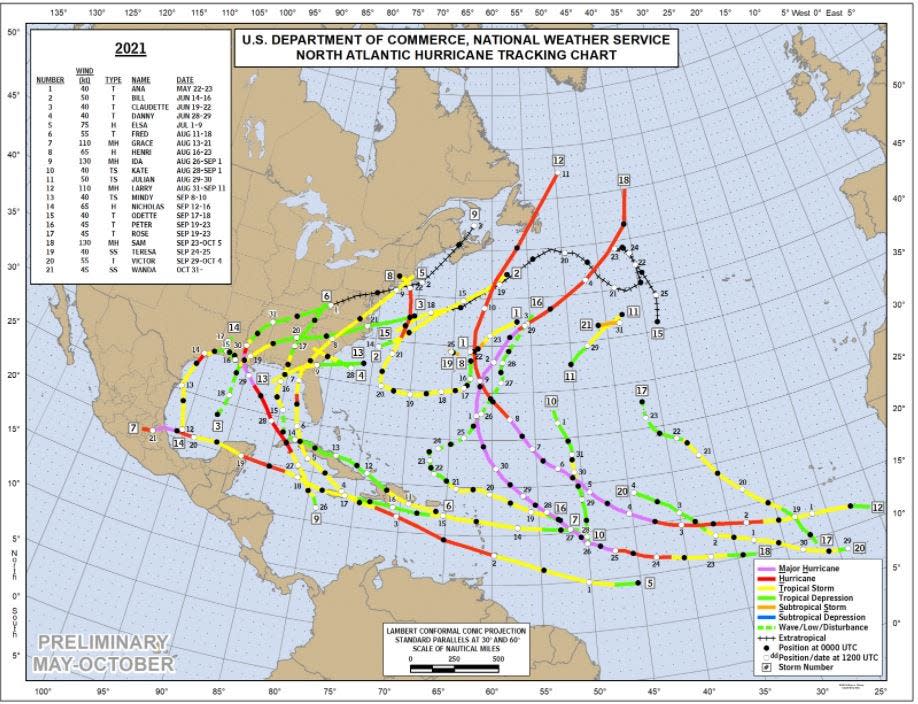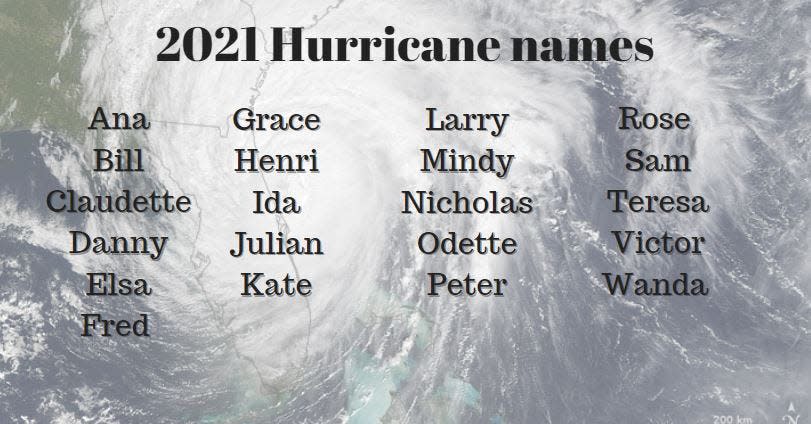2021 hurricane season ends on a whimper, but still busier than normal with one big horror
The 2021 hurricane season ended above average for the sixth consecutive year, exhausting the storm name list – again – and birthing a spree killer that brutalized areas from Louisiana through Connecticut.
Despite the overachieving season, which ends Tuesday, the Florida Peninsula remained unscathed with not even a near-miss from a malcontent tropical cyclone. The same can’t be said for the Panhandle, which was burdened by three landfalling storms that racked up more than $2 billion in damage in multiple states.
Hurricane experts reviewing the 21 named storms of 2021 noted two standout events: Category 4 Hurricane Ida’s Aug. 29 crash into Louisiana that took the lives of an estimated 95 people in seven states over three to four days, and the sudden fizzle of a season that many thought would be backloaded by the October entrance of La Niña.
More: What is a 'brown ocean' and how did it turn Ida into such a monster hurricane?
More: Claudette was one for the record books in a way that we may not see again in our lifetime
Instead, the season wheezed to an end with harmless Tropical Storm Wanda, which faded into oblivion 380 miles west of the Azores on Nov. 7.
“I was saying ocean temperatures are warmer than average and waters off Mexico and Florida are warm and there’s La Niña, so odds are we are going to get an active end of season,” said Jeff Masters, a meteorologist for Yale Climate Connections and a co-founder of Weather Underground. “But the weather and climate system is chaotic. It doesn’t always behave in the way people expect it to.”
It's a wrap: a 54-hour radar loop of #Ida's approach, landfall, and decay... now part of the collection of 480+ TC radar loops at https://t.co/O5tXQxhxEP @UMiamiRSMAS @capitalweather pic.twitter.com/gsb0LY4H7X
— Brian McNoldy (@BMcNoldy) August 30, 2021
While those late-season forecasts may have been off, seasonal predictions made prior to the June 1 start date were mostly pointing to another lively year.
And they were verified with the 21-storm total, including seven hurricanes, of which four were major hurricanes of Category 3 or higher.
A normal season has 14 named storms and seven hurricanes, including three major hurricanes.
More: Greek alphabet banned after names confused people; Four hurricane names retired
More: Scary trend: Major hurricanes in October and November — why is it happening?

Eight storms hit the U.S. this past season. That’s above the long-term average of three to four U.S. landfalls but lower than the 12 storms that breached U.S. shores during the hyperactive 2020 season.
“This year we had Henri, Ida and Fred causing billions of dollars in damages,” said AccuWeather lead hurricane forecaster Dan Kottlowski. “Ida was by far the worst.”
Ida splashed through a warm eddy in the Gulf of Mexico, where it gained a staggering 50 mph in less than 24 hours. By the time it reached the marshy fringe of Louisiana, it was a 150-mph cyclone that maintained major hurricane muscle for eight hours after landfall.
As Ida moved to the northeast, rain totals of 3 to 8 inches were widespread from Maryland through southern New England. Deadly flooding hit New York City and New Jersey, where a combined 50 people died, mostly from drowning, according to the federal Centers for Disease Control and Prevention.
The National Centers for Environmental Information estimate Ida’s damages at $64.5 billion.
More: Hurricane spaghetti models: Things you need to know to track the models
More: Hurricane Sally's stall was calamitous for Gulf Coast; will slow-moving storms be a trend?
“Ida was the story of 2021,” said Colorado State University atmospheric research scientist Phil Klotzbach.
There were also several “shorties” – a term Klotzbach said was coined by a National Hurricane Center forecaster for storms with limited lifespans.
Nine storms lasted fewer than two days. But they still add to the overall tally, which for just the third time in history ran through the full list of designated storm names. The two previous overly prolific years were 2020 with 30 named storms and 2005 with 28 storms.
The 2021 season stopped short of having to use a new list of alternative names approved by the World Meteorological Organization in the spring.

“This year you either had short-lived junk or long-lived major hurricanes,” Klotzbach said. "It was a funky bifurcated season from an intensity and longevity perspective."
The NHC began issuing regular tropical outlooks on May 15 this year, ahead of the official storm season start date of June 1.
The move was prescient as Tropical Storm Ana formed northeast of Bermuda on May 22 marking the seventh consecutive year Mother Nature jumped the gun on man's official calendar.
Ana was followed by Tropical Storm Bill, which plodded into oblivion after forming June 14 of the coast of North Carolina. Tropical Storm Claudette formed just inland of Louisiana's coast on June 19 ahead of Tropical Storm Danny, which made landfall north of Hilton Head, S.C., on June 28.
Elsa – the first hurricane of 2021 and the earliest forming fifth named storm on record – made landfall July 7 in Florida's Big Bend region as a high-end tropical storm.
Then there was an unsettling, although not unusual, break in activity through early August when Tropical Storm Fred formed, making landfall near Apalachicola on Aug. 16.
A terrible windfall followed Fred with major Hurricane Grace hitting Mexico Aug. 21, Henri making landfall as a tropical storm in Rhode Island on Aug. 22 and Hurricane Ida decimating parts of Louisiana with 150-mph Cat 4 winds on Aug. 29.
Tropical storms Julian and Kate came and went unnoticed. Larry – the season's third major hurricane – formed Aug. 31. Tropical Storm Mindy formed Sept. 8, just four hours before making landfall at St. Vincent Island near Apalachicola.
Weather Plus: Sign up for our weekly newsletter
Stay prepared with weather-related news, including hurricane updates with Weather Plus
The eighth – and final – storm to make a U.S. landfall this season was Hurricane Nicholas, which hit Texas in the pre-dawn hours of Sept. 14 as a Category 1 hurricane with 75 mph winds.
Brian McNoldy, a senior research associate at the Rosenstiel School of Marine and Atmospheric Science at the University of Miami, said preliminary estimates rank 2021 as the fourth costliest Atlantic hurricane season. Top ranked is 2017, followed by 2005 and 2012.
McNoldy notes that 2021’s accumulated cyclone energy (ACE) – a measure of storm strength and longevity – was 145 units. That’s above the average of 121 units and marks 2021 also as the sixth consecutive year where ACE was 129 units or higher.
“This has never happened before, not during the satellite era, not since records began in 1851,” McNoldy wrote in his blog. “This sustained level of tropical cyclone activity in the Atlantic is unprecedented even for four years, let alone six.”
Kimberly Miller is a veteran journalist for The Palm Beach Post, part of the USA Today Network of Florida. She covers weather, climate and the environment and has a certificate in Weather Forecasting from Penn State. Contact Kim at kmiller@pbpost.com
This article originally appeared on Palm Beach Post: Hurricane season 2021 ends with three Florida storm landfalls

